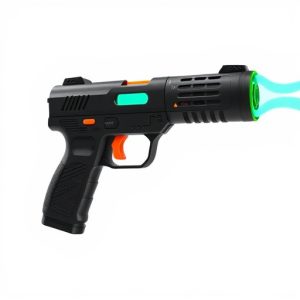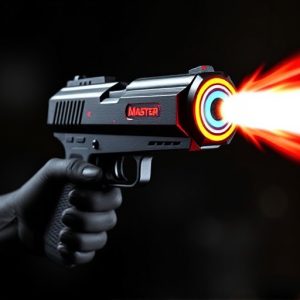Master Blaster Stun Gun: Pulse Frequency, Safety, and Science
The Master Blaster stun gun delivers powerful, non-lethal electrical pulses to temporarily disable t…….
The Master Blaster stun gun delivers powerful, non-lethal electrical pulses to temporarily disable targets, with its effectiveness adjusted through variable pulse frequency (up to 200Hz+). Key factors like battery power and circuit design influence this frequency, catering to law enforcement's need for rapid pulses vs. personal defense users' preference for sustained, lower frequencies. Safety and local regulations are paramount when using a Master Blaster stun gun, requiring proper training, handling, and maintenance.
“Uncover the power behind stun guns with our comprehensive guide. ‘Understanding Stun Guns’ explores the intricate world of these non-lethal self-defense devices, while ‘The Science Behind Electrical Pulse Frequency’ delves into the vital role of pulse rate in their effectiveness.
‘Master Blaster Stun Gun’ takes center stage as we unravel its unique features and performance. We also examine factors influencing pulse frequency, highlighting critical considerations for users. Finally, ‘Safety and Regulations’ ensures you’re armed with knowledge, not just power.”
- Understanding Stun Guns: A Comprehensive Overview
- The Science Behind Electrical Pulse Frequency
- Master Blaster Stun Gun: Unveiling Its Features
- Factors Influencing Pulse Frequency in Stun Devices
- Safety and Regulations: Considerations for Users
Understanding Stun Guns: A Comprehensive Overview
Stun guns, often referred to as master blasters, are non-lethal weapons designed to incapacitate a target through an intense electrical pulse. They operate by delivering a strong electric current that disrupts the target’s nervous system, causing temporary paralysis and disorientation. This technology has gained significant attention due to its use by law enforcement and personal defense enthusiasts.
These devices fire a short-duration, high-voltage charge, typically in the form of a 50,000-volt pulse, which can be delivered over a range of several feet. The electrical pulse frequency plays a crucial role in their effectiveness; higher frequencies can lead to more precise and quicker impacts, while lower frequencies may result in longer-lasting effects. Understanding this dynamic is essential for users to make informed decisions when choosing a stun gun, ensuring it meets the specific needs and requirements of different situations.
The Science Behind Electrical Pulse Frequency
The effectiveness of a stun gun, like the popular Master Blaster model, heavily relies on its electrical pulse frequency. This frequency determines how quickly and powerfully the device delivers electric shock to immobilize a target. Stun guns use high-voltage, low-current electrical pulses to disrupt muscle control in the body, causing temporary paralysis. The pulse frequency is measured in hertz (Hz), representing the number of complete cycles per second.
In the case of Master Blaster stun guns, manufacturers typically design them with adjustable pulse frequencies, ranging from 100Hz to over 200Hz. Higher frequencies mean more rapid and intense pulses, which can increase the weapon’s effectiveness but also may cause more pain and discomfort for the target. This adjustability allows users to tailor the device’s performance based on specific situations and personal preferences, ensuring optimal stun capability while adhering to safety guidelines.
Master Blaster Stun Gun: Unveiling Its Features
The Master Blaster Stun Gun stands out as a formidable device in personal defense, renowned for its powerful electrical pulse frequency that delivers an intense shock. This innovative weapon is designed to incapacitate an aggressor temporarily, giving users the crucial time to escape dangerous situations. Its high voltage and precise waveform ensure maximum effectiveness while minimizing risk to bystanders.
Equipped with advanced technology, the Master Blaster offers a range of features that set it apart. A fully adjustable pulse width allows for customization to suit different scenarios, from close-quarters encounters to longer-range deterrents. Additionally, its smart circuit design provides superior safety, preventing accidental discharge and ensuring user control. The sleek, ergonomic design makes it easy to conceal and carry, making the Master Blaster a preferred choice for individuals seeking an effective yet discreet self-defense solution.
Factors Influencing Pulse Frequency in Stun Devices
The pulse frequency of a stun device, like the Master Blaster stun gun, is influenced by several key factors. One primary factor is the power source—whether it’s batteries or an internal rechargeable system—and its capacity. Higher voltage and more robust batteries can enable faster pulses, increasing the stun device’s effectiveness. Additionally, the electrical circuit design plays a crucial role; advanced circuitry allows for precise control over pulse duration and frequency, enhancing the device’s performance.
Another significant consideration is the stun gun’s intended use. Different scenarios demand varied pulse frequencies. For instance, law enforcement officers might prefer a higher frequency for rapid successive pulses during confrontational situations, while personal defense users could opt for a lower, more sustained pulse to immobilize an attacker without causing permanent harm. Moreover, weather conditions can also impact performance; extreme temperatures can affect battery life and electrical conductivity, subsequently influencing the pulse frequency.
Safety and Regulations: Considerations for Users
When using a master blaster stun gun, safety and regulations are paramount. Users must be aware of local laws and comply with all relevant regulations regarding the possession and use of stun devices. It’s crucial to understand the specific legal implications in your area, as regulations vary widely from place to place.
Additionally, proper handling and usage practices are essential. Stun guns deliver powerful electrical pulses that can cause temporary incapacitation, but they should only be employed as a last resort for self-defense. Users must receive adequate training on safe usage, including awareness of the device’s range, activation mechanisms, and potential side effects, such as pain or muscle strain from the shock. Regular maintenance and inspections are also vital to ensure the stun gun remains in good working order, maximizing safety during its deployment.
In conclusion, understanding electrical pulse frequency in stun guns, such as the Master Blaster Stun Gun’s advanced features, is key to navigating this dynamic field. Various factors influence these frequencies, necessitating safety and regulatory considerations for users. By staying informed about the science behind pulse intensity and device functionality, individuals can make educated decisions when selecting and employing stun devices for personal safety.


